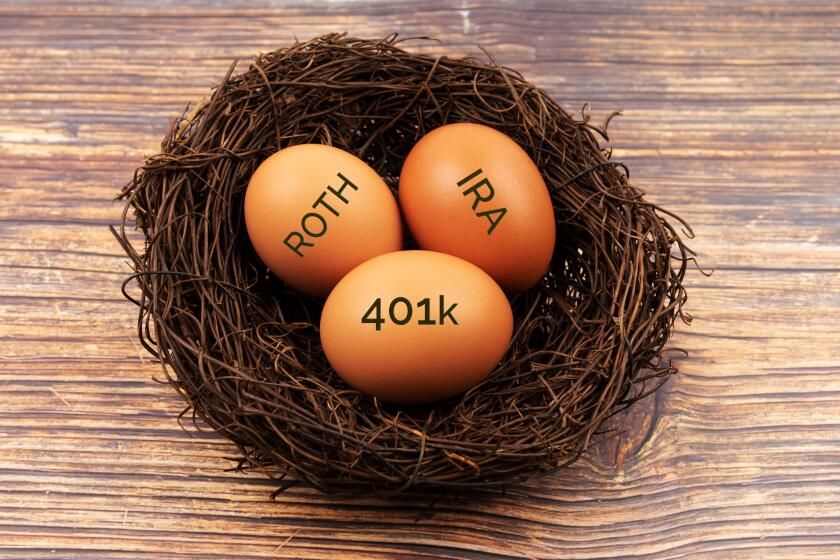The rules have changed on inherited IRAs. Here’s what you need to know

- Share via
Dear Liz: My husband and I have a combination of traditional and Roth IRAs naming our children and grandchildren as beneficiaries. With the passage of the Secure Act requiring distribution of inherited IRAs within 10 years, we want to revise our plan of leaving all of the investments to our children, as such inherited income would affect their tax bracket also. Do you have recommendations to alter the inherited IRAs to avoid this issue? Our annual fixed income puts us at the top of our tax bracket, meaning we usually cannot manage a traditional IRA to Roth conversion.
Answer: The Secure Act dramatically limited “stretch IRAs,” which allowed people to draw down an inherited IRA over their lifetimes. Now most non-spouse inheritors must empty the accounts within 10 years if they inherited the IRA in 2020 or later.
There are some exceptions if an heir is disabled, chronically ill or not more than 10 years younger than the IRA owner, says Mark Luscombe, principal analyst for Wolters Kluwer Tax & Accounting. These “eligible designated beneficiaries” can use the old stretch rules, as can spouses. Minor children of the IRA owner can put off withdrawals until age 21. At that point, the 10-year rule applies.
If you had a potential heir who qualifies, you could consider naming them as the beneficiary of a traditional IRA and leaving the Roth money to the other heirs. (The IRA withdrawals will be taxable while the Roth withdrawals won’t.) Or you could leave the IRA to the children in lower tax brackets and the Roth to those in higher tax brackets.
If you’re trying to divide your estate equally, though, these approaches could vastly complicate matters because the balances in the various accounts could be quite different. Plus, predicting anyone’s future tax brackets can be tough.
Another approach is to name your children along with your spouse as the primary beneficiary of your IRA. That way, the children would get 10 years to spend down this first chunk of your IRA money after you die. When your survivor dies, they would get another 10 years to spend down the remainder, giving them 20 years of tax-deferred growth.
Alternately, you could focus on spending down the IRA to preserve other assets for your kids. The stretch IRA rules encouraged people to preserve their IRAs, but now it may make more sense to focus on passing down assets such as stock or real estate that would get a valuable “step up” in tax basis at your death.
Converting IRAs to Roths is another potential strategy for those willing and able. In essence, you’re paying the tax bill now so your heirs won’t have to pay taxes later (although they’ll still have to drain the account within 10 years). It may be possible to do partial conversions over several years to avoid getting pushed into the next tax bracket.
There are a few other approaches that involve costs and tradeoffs, such as setting up a charitable remainder trust that can provide beneficiaries with income. These are best discussed with an estate planning attorney who can assess your situation and give you individualized advice.
These retirement researchers suggest maximizing Social Security and basing account withdrawals on the IRS’ required minimum distribution percentages.
Figuring taxes on Social Security
Dear Liz: How will our Social Security payments be affected by any passive income such as from rental properties? We have two properties, which add $3,000 monthly to our current income. I plan on retiring at 72, which is six years away. My husband may retire earlier due to health problems. We will have savings as well as my 401(k) when I retire. Although my retirement income “pencils out,” I don’t know exactly what to expect from Social Security. How should I calculate my net income in retirement?
Answer: You could pay income taxes on up to 85% of your Social Security benefits if you have other taxable income. Examples of taxable income include wages, interest, dividends, capital gains, rent, royalties, annuities, pension payments and distributions from retirement accounts other than Roths.
To determine how much of your benefit is taxable, you would first calculate your “combined income,” which consists of your adjusted gross income plus any nontaxable interest you receive plus half of your Social Security benefits. If you file a joint return, you typically would have to pay income tax on up to half of your benefits if your combined income fell between $32,000 and $44,000. If your combined income was more than $44,000, up to 85% of your benefits would be taxable.
Liz Weston, Certified Financial Planner, is a personal finance columnist for NerdWallet. Questions may be sent to her at 3940 Laurel Canyon, No. 238, Studio City, CA 91604, or by using the “Contact” form at asklizweston.com.
More to Read
Inside the business of entertainment
The Wide Shot brings you news, analysis and insights on everything from streaming wars to production — and what it all means for the future.
You may occasionally receive promotional content from the Los Angeles Times.











